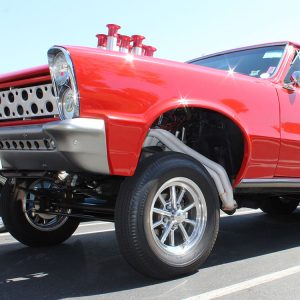History of the Automotive Wheel
In order to discuss the history of the automotive wheel, let’s first define the different elements that make up a wheel. First there is the HUB, which attaches to the axle of the vehicle. The hub supports the outer RIM, which the tire surrounds. There are two different sources for attaching the hub to the rim: Spokes or Discs. Spokes could be made from any hard and strong material such as steel wire or wood. The discs may be cut out to provide holes for lightening and design or left solid. They may be pressed in, riveted, or welded on the rim and hub. Modern discs may have the hub incorporated within it.
 Since 1885 when Karl Benz created the Motorwagen, arguably the first self-propelled automobile, wheels have gone through many stages. The Motorwagen was a three-wheeled vehicle that used bicycle type wheels with thin wires holding the rim to the hub and fitted with hard rubber. Ford’s Model T used wooden spoke artillery type wheels with a steel hub and rim until 1926-27 when they changed to a welded steel spoke design.
Since 1885 when Karl Benz created the Motorwagen, arguably the first self-propelled automobile, wheels have gone through many stages. The Motorwagen was a three-wheeled vehicle that used bicycle type wheels with thin wires holding the rim to the hub and fitted with hard rubber. Ford’s Model T used wooden spoke artillery type wheels with a steel hub and rim until 1926-27 when they changed to a welded steel spoke design.
 During that same time in the mid-1920’s a new revolution in wheel design was to replace the spokes with stamped steel discs. Discs were lighter, stiffer and resistant to damage. An added benefit for this design to take off was the ability to mass-produce them, thus making them more economical to produce. The disc was stamped from sheet metal and wither welded or riveted to the rim.
During that same time in the mid-1920’s a new revolution in wheel design was to replace the spokes with stamped steel discs. Discs were lighter, stiffer and resistant to damage. An added benefit for this design to take off was the ability to mass-produce them, thus making them more economical to produce. The disc was stamped from sheet metal and wither welded or riveted to the rim.
In the mid-1930’s a dropped center steel rim with steel spokes became the industry standard. There were many different designs of how the spokes laced the hub to the rim. A criss-cross design going from the tangent of the hub was the most popular.
 For the next thirty years only slight changes in design of the steel centers and spokes were employed. In 1960 aluminum casting experiments in alloy recipes made durable strong designs. Metallurgy technology has helped the wheel industry. Steel and Alloy (such as billet aluminum) are the two type of wheels used in the automotive industry today. Wheels have become light-weight, more durable, nearly infinite styles, and safer.
For the next thirty years only slight changes in design of the steel centers and spokes were employed. In 1960 aluminum casting experiments in alloy recipes made durable strong designs. Metallurgy technology has helped the wheel industry. Steel and Alloy (such as billet aluminum) are the two type of wheels used in the automotive industry today. Wheels have become light-weight, more durable, nearly infinite styles, and safer.
Another thirty years and wheel sizes started a steady increase in size from 15” to over 20” in diameter. The larger designs were helpful in increasing brake sizes. “Spinners”: Two-piece wheels with a bearing in the center were introduced in the 1990’s this allowed the center design to spin at a different rate than the outer rim and tire. Some were weighted to remain stationary to accompany static design, and even advertising. The fad quickly faded.
 The classics live on. Classic designs such as those available at Wheelsmith continue to thrive at different sizes. For example you can now get the classic steel Rallye design in 20” billet aluminum.
The classics live on. Classic designs such as those available at Wheelsmith continue to thrive at different sizes. For example you can now get the classic steel Rallye design in 20” billet aluminum.
The future of the automotive wheel includes the “Tweel” a mashup of a non-pneumatic tread bonded to the wheel with flexible spokes. Currently used in slow moving construction equipment, more testing and experimentation is being done to reduce shake at higher speeds. Another future development is being tested in electric vehicles, which incorporate an active motor in each wheel.
 At Wheelsmith, we are all about building classic wheel designs per order, so you get the right wheel for your car. Take a look at our catalog of designs and call today to order the perfect fit for you and your pride and joy.
At Wheelsmith, we are all about building classic wheel designs per order, so you get the right wheel for your car. Take a look at our catalog of designs and call today to order the perfect fit for you and your pride and joy.

